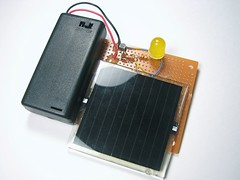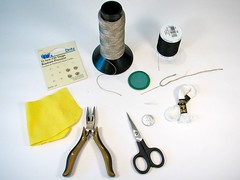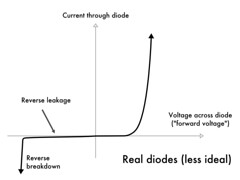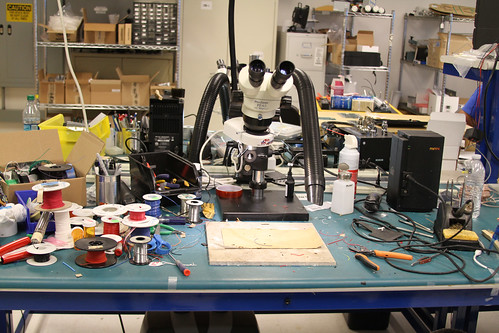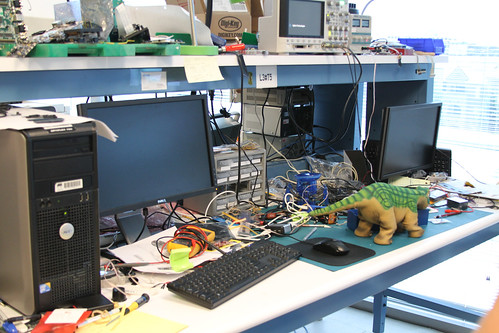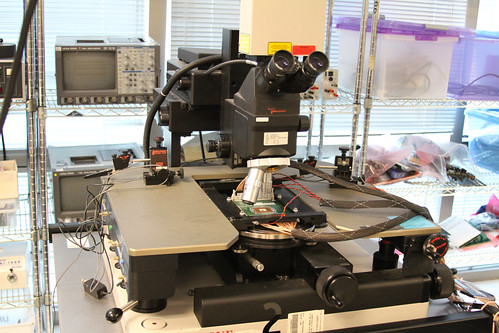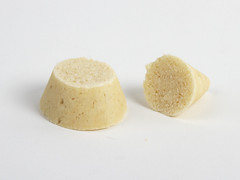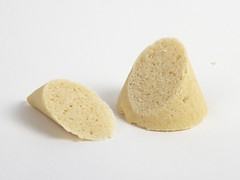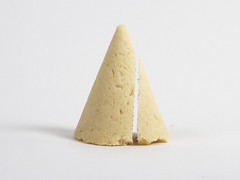Our collaborator Sylvia went on the Katie Couric show yesterday. She showed off the WaterColorBot and did a couple of science demonstrations with Katie. Her video segments are here and here. Fantastic job, Sylvia!
Category Archives: Education
Introducing The WaterColorBot
Today we’re thrilled to be launching our newest kit: the WaterColorBot.
The WaterColorBot is a brand-new project from Evil Mad Scientist Laboratories and Super Awesome Sylvia — a friendly art robot that moves a paint brush to paint your digital artwork onto paper, using a set of watercolor paints.
We’ve previously written about how we got started on this project (in a guest post by Sylvia), and about Sylvia’s visit to the White House Science Fair, where she was able to give President Obama a personal demonstration of the WaterColorBot.
And now, you can get one too! We’re launching the WaterColorBot today on Kickstarter, and we’d like to ask for your support in getting it out there. The WaterColorBot is an enormously powerful tool for helping to get young people interested in technology:
Beyond simple fun, we think that the WaterColorBot has enormous potential for STEM and STEAM education, especially as a way to get young people engaged with hands-on technology and robotics. We are particularly interested finding ways to inspire young women to pursue careers in science and technology. We cannot imagine any better way to do so, than starting with a robot co-designed by a 12 year old girl.
Perhaps more than anything else that we’ve done, we think that the WaterColorBot really can make the world a better place, one (young) Evil Mad Scientist at a time.
Maker Camp: Robots

Today, Tuesday, July 16, Super Awesome Sylvia and I will be joining Maker Camp for a special Google+ hangout focused on robots at 1 pm PDT. Sylvia will be demonstrating her WaterColorBot, which we’ve worked together on.
We’ll be on after our good friend, Erin RobotGrrl, shares some of her robot-building techniques in Robot Hangout #1 at 11 am PDT.
A round up of our “Basics” articles
Over the course of the past few years, we’ve been writing occasional “Basics” articles, about introductory topics in electronics and microcontrollers. In the spirit of making things easy to find, we’ve now tagged them so that you can find them with this link, and we’re collecting them together in this index that will be updated from time to time.
Our “Basics” articles about electronics in general:
- Basics: Picking Resistors for LEDs
- Basics: Finding Pin 1
- Basics: Open Collector Outputs
- Basics: Simple LED Pumpkins
- Simple Solar Circuits
- Basics: Introduction to Zener Diodes
- Basics: Power Dissipation and Electronic Components
- Soft Circuit Merit Badge
- Basics: Up Close and Personal with Solder Paste
- Five Electronics Tools You Might Not Know About and More Cool Electronics Tools
- Tricks of the trade: Twisting wire bundles
Additional “Basics” articles about working with AVR microcontrollers:
- Basics: Blink an LED with an AVR microcontroller
- Using AVR microcontrollers: Minimalist target boards
- Basics: Serial Communication with AVR Microcontrollers
- Basics: Using an Accelerometer with an AVR Microcontroller
- AVR Basics: Reading (and writing) flash contents
- Quick and Dirty D to A on the AVR: A timer tutorial
- Resources for getting started with AVRs
Field Trips: Atmel Headquarters
Super Awesome Sylvia and I were invited to attend Bring Your Kids to Work Day at Atmel recently. (Atmel, of course, is the company that makes the microcontrollers found inside Arduino products and in many of our own projects and kits.) We were there to help provide tangible, interesting, and playful examples of how Atmel chips can be used. And of course, we weren’t going to miss an opportunity to visit Atmel headquarters!
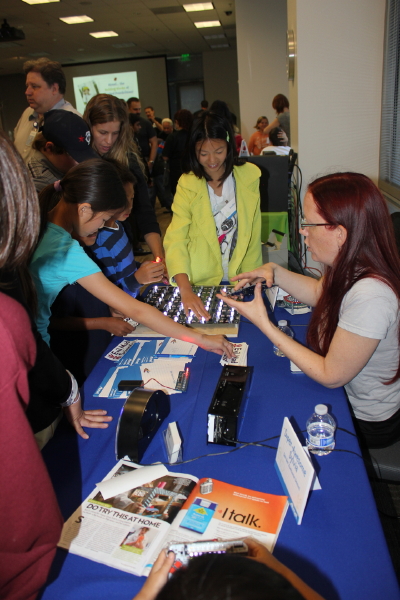
The biggest hit with the kids were the Octolively interactive LED modules (sporting the Atmel ATmega164P). When the kids waved their hands over them, the LEDs would light up and ripple. Some of the kids would start out by poking and grabbing at the LEDs until they lit up, but as soon as I told them it would work “even without touching it” their eyes would get big, and they’d wave their hands over the top, enthralled.
Some of the other things we brought were our handheld game, the Meggy Jr RGB (with the ATmega328P); a Bulbdial Clock (Atmega328P again), which points rings of LEDs at different heights down at a central point to create shadow hands of different lengths; our giant Alpha Clock Five (ATMega644A); and the Larson Scanner (ATtiny2313A), which lights up nine red LEDs to make a scanning robot eye.

Another project that captured the kids’ attention was a Keepon by BeatBots. Other demonstrations included a quadcopter and a hacked hexabot.

We got to have lunch in the bright sun in the courtyard with Avary Kent, who was demonstrating the PuzzleBox, a brain-controlled helicopter.

Sylvia got to give the PuzzleBox a try, triggering it to fly as soon as she concentrated hard enough.
After lunch, we got to tour of a couple of labs. This workbench was well stocked with a Metcal soldering iron (our favorite) and lots of tools and supplies.
Apparently the poor Pleo on this bench needed some repair.
This machine is for inspecting and testing chips after they have been removed from their housing.
We got to go into the RF anechoic chamber, and watch as our cell phones stopped receiving any signals.
We also had some time to hang out and horse around with friends new and old. Our friend Paul Rako seemed to be having as much fun as the kids.

Thanks to Paul and Atmel for inviting us to visit!
From the Mailbag: On the Digi-Comp II
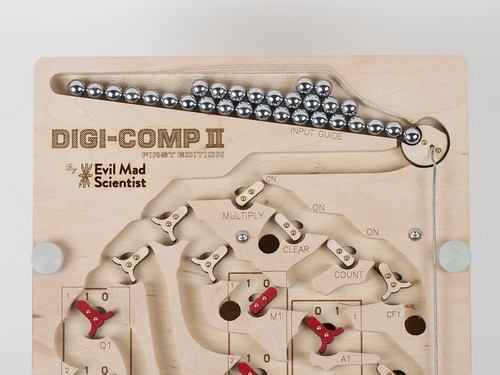
Peter wrote in about his experience with the Digi-Comp II:
I just wanted you and the entire Evil Mad Scientist team to know that the Digi-Comp II was a big success. I used it to explain digital computers to a group of second graders and fifth graders. In an age of iPads and smartphones, it’s surprisingly hard to demonstrate the beauty and magic of digital computer. The Digi-Comp II was perfect, looked great, and worked flawlessly. Thanks!
Play with your food: How to Make Sconic Sections
The conic sections are the four classic geometric curves that can occur at the intersection between a cone and a plane: the circle, ellipse, parabola, and hyperbola.
The scone is a classic single-serving quick bread that is often served with breakfast or tea.
And, at the intersection of the two, we present something entirely new, delightfully educational, and remarkably tasty: Sconic Sections.
In what follows, we’ll show you how to bake cone-shaped scones, to slice them into plane geometric curves, and to highlight those curves by selective application of toppings. We’ll also discuss some of the methods that didn’t work so well, as we refined our methods for making these.
Onwards, towards parabolic preserves and hyperbolic Nutella!
Continue reading Play with your food: How to Make Sconic Sections
Super Awesome Sylvia in People Magazine

You may already be familiar with Super Awesome Sylvia, who has been working hard with us on the WaterColorBot toward our planned launch in July. Sylvia was just featured in the June 24 issue of People Magazine. Way to go, Sylvia!
Previously: White House Science Fair Roundup
The Evil Mad Scientist STEAM T-shirt
Introducing the Evil Mad Scientist Laboratories STEAM T-shirt. Featuring high quality screen printing on 100% cotton tees from American Apparel.
Front side: Science & Technology & Engineering & Art & Mathematics. (Black ink)
Back side: The Evil Mad Scientist logo. (Red, brown, and black inks)
Shirt color: “New Silver,” a uniform light gray.
These are Great Shirts
Beautiful quality screen printing by Social Imprints of San Francisco (“Printing with Purpose”).
The shirts themselves are comfortable 100% cotton tees, made in the USA by American Apparel. (Mens Fine Jersey Short Sleeve T-Shirt and Womens Fine Jersey Short Sleeve Women’s T.)
Inspiration
The design of the front is an homage (like so many others) to the John Paul Ringo George shirt by Experimental Jetset.
Why Science & Technology & Engineering & Art & Mathematics?
It’s who we are, and it’s what we stand for.
Why not just STEM?
We, like many, many others believe that art is a critical component of good design, of good engineering, and of beneficial technology.
Get yours
The Evil Mad Scientist STEAM T-shirt is in stock and shipping now!
Eggbot, iPad and Raspberry Pi

After seeing the Eggbot at Maker Faire, and seeing that it could be used with a Raspberry Pi, John Biehler got one. He hooked it up to his Raspberry Pi, went on to control his Raspberry Pi with his iPad, and took it to Maker Faire. Full circle! He has lovingly documented the process on his site.






